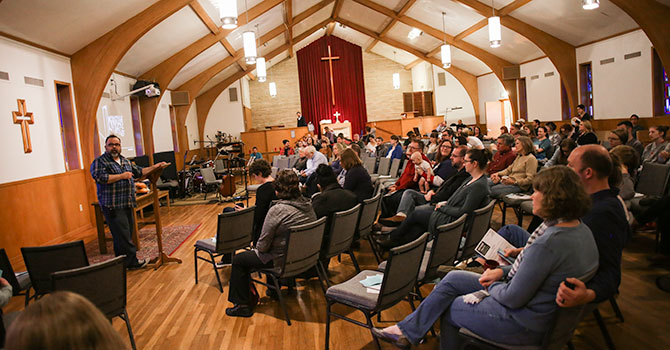On Ash Wednesday, the fellowship hall at Servant Church in Austin, Texas, buzzed with chatter and children’s laughter as young families gathered to share soup and bread before the evening service. When Deacon Abby Parker Herrera jumped up on the stage to offer a blessing, she had to clang an iron-triangle dinner bell to quiet the room. As soon as she uttered “Amen,” the cacophony resumed.
Seated at the end of a long folding table, her wheeled walker parked nearby, 92-year-old Mary Ruth Borges beamed. She could barely hear her dinner companions over the noise. But that was a happy problem.
“It makes my heart feel good to see them,” she said, gazing at the young families surrounding her.

For decades, children -- and even young adults -- were rarely seen inside the walls of the midcentury stone church, formerly known as Asbury United Methodist. Launched after World War II in a thickly settled neighborhood in Central Austin, Asbury was once a thriving congregation. But over years of decline, as founding members aged into their 80s and 90s, new people quit coming.
By the mid-2000s, officials at the Rio Texas Annual Conference saw only two options -- deep change or slow death -- and proposed planting a young congregation at Asbury to revitalize the place. Members, many of whom had built Asbury 60 years earlier, faced a question steeped in resurrection theology: Would they be willing to let their church die in order to have new life?
With the conference’s encouragement, Asbury members in 2010 invited Servant Church, a small group of 20- and 30-somethings, to worship in the fellowship hall. Over the next six years, as the new congregation thrived and the old one withered, Asbury began letting go, eventually relinquishing the entire church to Servant. The transition was fraught with resentment and grief but also buoyed by faith and hope. Asbury found an unexpected legacy, and Servant made the church new again.
If your church closed tomorrow, what legacy would it leave?
Today, Servant Church is a lively, seeker-friendly congregation intently focused on the neighborhood and surrounding community. With a casual and imaginative worship that appeals to Austin’s creative types, Servant Church may not look or feel like Asbury. But at its core, in its own way, it is re-enacting the same story of a young church just starting out.
Asbury’s story
Asbury’s story began in 1948, in the postwar boom that transformed the area northeast of downtown Austin from ranches and farms to homes and businesses. One Sunday, 22 people gathered in the backyard of Sonny and Louise Jones to start a Methodist church.
They broke ground on the fellowship hall the following year, eventually adding a chapel and preschool and finally completing the sanctuary in 1957. The sprawling structure occupied the corner of a bustling intersection and drew young working- and middle-class families from the surrounding Cherrywood neighborhood.
Borges started attending Asbury with her mother and 2-year-old son in 1952. The congregation grew rapidly, she said, thanks to dedicated members.
“We all pitched in,” recalled Borges, who taught Sunday school and volunteered for various committees and ministries.

Nancy Kier, whose family joined Asbury in 1955 when she was 3, remembered a “booming” church with a large choir and 300 people in the pews on Sundays. Asbury sponsored youth groups, Boy Scout troops and Vacation Bible School.
How does your church’s story fit into the larger story of church in America?
But as the decades wore on, the church began to lose the younger generation.
“As kids began growing up and leaving home, … we didn’t draw in as many new ones, I guess,” Borges said.
Including her son, Darryl Borges. When he and his wife moved back to Austin in 1978, a baby daughter in tow, they planned to rejoin Asbury. But looking around the sanctuary, they realized that nobody else had babies. The young family decided to find a different United Methodist church.
By the time the conference did an assessment of Asbury in the mid-2000s, the church had been struggling for years. Members donated to charities, held fellowship dinners and participated in church circles, Kier said. But age and physical limitations prevented them from doing much in the way of outreach.
Still, the conference saw potential in the location. Situated at a busy intersection in a trendy Central Austin neighborhood not far from the University of Texas, Asbury was surrounded by people. The church just wasn’t reaching them.
Overcoming resistance
The district superintendent at that time, the Rev. Bobbi Kaye Jones, together with others, suggested planting a young congregation there. But the idea met with fierce resistance from many members, said the Rev. Diane Lee, a former Asbury member who served as the church’s pastor in the final years.
“Some of the leaders were very territorial,” Lee said. “They didn’t welcome young people. There was one person who said, ‘We don’t want any children here.’”
Again and again, Jones reminded Asbury members that they faced a choice: deep change or slow death. Asbury had to try something new -- or it would have to close.
In what ways if any does Asbury UMC’s choice -- deep change or slow death -- apply to your church? To the church broadly?
In 2009, conference leaders asked the Rev. Eric Vogt, a minister in his mid-30s fresh out of Duke Divinity School, to plant Servant Church at Asbury. Vogt and his wife, the Rev. Valerie Vogt, also a Duke Divinity grad, weren’t United Methodists -- Eric was ordained by a quasi-Baptist Austin church; Valerie, by the Presbyterian Church (U.S.A.) -- but they both felt a calling to work with young people in Austin. And they were willing to undergo the United Methodist ordination process.
But would Asbury members go along with the plan?
Jones appealed to their sense of stewardship.
“I kept talking to them about their spiritual grandchildren,” she said. “Aren’t you lucky that you get to see that rather than close your church?”

Mary Ruth Borges agreed and urged other members to support Servant Church.
“Mother was one of the ones going around saying …, ‘OK, this is how we can keep this going. This is the way it needs to be,’” Darryl Borges said.
Navigating new terrain
Though Asbury members eventually voted to allow Servant Church to worship in its fellowship hall, about a third opposed it.
Jones received angry letters. One member accused Lee of not loving Asbury. Some left. Even those who voted in favor of Servant weren’t sure how the arrangement would work.
Vogt was navigating new terrain, too. His years at a startup church had equipped him to reach Austin’s young creative types wary of traditional churches. Before that, he had worked with college students through InterVarsity Christian Fellowship.
But now he was sharing space with an elderly congregation, some of whom didn’t want him there. Vogt could cite the passage from John about the seed needing to die in the earth in order to bear fruit. But would that comfort an old woman who had baptized her children at Asbury and now felt she was being pushed out?
Vogt also felt the pressure of expectation from the United Methodist leaders who received him.
“They took a risk on me,” he said. “Why would we invest in this place that has shown itself to be dead? Why would you think there’s new life there?”
In September 2010, Servant Church hung its shingle on the stone facade, and a small group of people in their 20s and 30s began meeting in the fellowship hall, now redecorated with Ikea lamps and throw rugs. They sang traditional hymns set to new music driven by electric guitars and drums and began knocking on doors to meet their new neighbors.

The goal was to establish a parish mentality focused not on the church itself but on the broader community outside its walls, said Vogt.
“We’re church for this place whether you come on Sunday morning or not,” he said. “We’re just here to try to love this place.”
They also tried to build relationships with their newly adopted spiritual grandparents, taking chocolate-covered strawberries to homebound Asbury members on Valentine’s Day and helping with Asbury’s beloved Easter egg hunt.
Swapping spaces
By July 2011, Servant’s Sunday attendance had grown to 100. The fellowship hall felt cramped. Meanwhile, Asbury’s attendance was plummeting.
“We were in the sanctuary in one little corner worshipping about 40,” Lee recalled.
The two congregations decided to swap spaces.
On Feb. 19, 2012 -- fittingly, Transfiguration Sunday -- Servant members joined Asbury in the sanctuary to receive the gift that would allow them to grow.
In a liturgy written by Herrera, Asbury members took turns sharing memories of the church, to which Servant members responded: “Well done, good and faithful servant.” Asbury members, in turn, said, “Now go and do likewise.” The tiny band of Asbury faithful returned to the fellowship hall where the church had begun more than 60 years earlier.
Servant members began to transform the sanctuary, replacing the original pews with chairs and reorienting the congregation toward the broad west wall rather than the altar. They set up a simple communion table and made space for the band. A galvanized livestock water trough served as a baptismal font.

“The people we’re trying to connect with aren’t looking for a United Methodist church,” Vogt said. “The more you play up the institutional aspects of it, the less trustworthy it seems.”
The approach worked for Ashley Croswell, a young lawyer whose childhood in evangelical and Baptist churches had soured her on religion. She hadn’t been to church in nine years when she tried Servant -- because “they didn’t seem crazy.”
Some Asbury folks bristled at the changes.
“This was not an easy task, because we had to hold a vision even though the vision could be hurtful and harmful to our grandparents,” Herrera said.
A lifelong United Methodist, Herrera sympathized with Asbury members grieving the loss of their church but argued that keeping dying churches on life support is “not a good use of property, of space, of energy.”
“At some point, you’re not a church anymore,” she said.
When is a church “not a church anymore?” Is it simply a matter of size?
Kier, the longtime member who had attended Asbury since she was 3, admitted that the church probably should have closed years earlier.
“They were just such good Christian ladies that you knew how much the church meant to them and how heartbreaking it would be when and if it closed,” she said. “We just wanted to keep it going as long as we could.”
In Asbury’s final year, Sunday worship dwindled to eight with a two-person choir, one of whom was the pastor. Sometimes, Lee would bring out the Cokesbury hymnals for old times’ sake.
By the summer of 2016, the remaining members were ready to bequeath the church to Servant. On June 26, after 68 years, Asbury held its final worship service. Officially, the two congregations merged, but hardly any Asbury members stayed.
Still, Lee said, “we knew we were doing the right thing and that a United Methodist presence would remain.”

Sundays at Servant Church
Sundays are now noisy, joyful affairs at Servant Church, drawing about 125 adults and 40-50 children. Young people in jeans and yoga pants linger under the oak trees sipping fair trade coffee donated by a nearby cafe. Children dart around the vestibule, laughing and grabbing doughnuts. Babies cry. Parents wrangle toddlers. Vogt, clad in flannel and Converse sneakers, greets people with hugs.
From the casual attire and the quirky service start time -- 11:11 a.m. -- to the floor-shaking music, the scene is a stark contrast to the traditional United Methodist services of the past.
Some traces of Asbury remain: the maroon curtain and long wooden cross behind the old altar, a few old pews, the lighting fixtures and narrow stained-glass windows.
But the former chancel now serves as a space for children to, as Valerie Vogt put it, “get their wiggles out” during service. There’s even a diaper changing station behind the old pulpit.
“It reinforces the family aspect of the church,” said Tom Meadows, a mohawk-sporting father of two small boys. “This is for the children.”

On a recent Sunday, even the sermon marked another departure from the older generation. Vogt preached the final installment in a series on sexuality and gender and explored the pitfalls of “purity culture and shame-based culture that [are] antithetical to grace.”
Servant’s evangelism also takes an edgier approach. In one ministry, members took cookies to dancers at a nearby strip club and invited them to pray and share meals with the congregation.
The church also holds immigration clinics and has formed a connection with a low-income neighborhood apartment complex occupied mostly by African-Americans. Members invite the residents to a monthly potluck and offer resources to struggling families.
Elizabeth Dickey, 46, said she was drawn to Servant because of the church’s emphasis on connecting with people outside the congregation.
‘What I was looking for’
“Our Sunday worship is a small part of the whole thing here,” she said, “and that’s what I was looking for.”
A sign on the bulletin board in the vestibule reads: “The work of the church is out these doors.”
That vision appeals to older Christians as well.
“My only wish is I had found a church like this 40 years ago,” said Dean Smith, a 65-year-old hospice chaplain.
As Servant Church thrives, members stay connected to the former Asbury members, visiting them in nursing homes and bringing them to church events. Two young couples share a monthly supper with Borges at her assisted living facility.
Vogt knows how easy it is to get complacent. Most Servant members are in their childbearing years. The pastors often baptize babies and rarely do funerals or hospital visits. But one day, he said, they too will have to “learn how to die.”
“When Asbury had 700 members in 1970, … I don’t think they could have known what was going to happen,” he said, sitting in the former chapel redesigned as a contemporary office and meeting space.
In a few decades, Servant Church could find itself in the same stagnant place as its predecessor.
In what season of life is your church?
“You’re going to have seasons of growth, and hopefully reproduction, and trying to have some legacy for later generations. … But then you get old, and you die, and you hand something on.”
He paused, then added, “I hope we can take what we’ve been given and love people well with it here and now.”
Questions to consider
Questions to consider
- If your church closed tomorrow, what legacy would it leave?
- How does your church’s story fit into the larger story of church in America?
- How well does your church reach people in the surrounding community?
- In what ways if any does Asbury UMC’s choice -- deep change or slow death -- apply to your church? To the church broadly?
- What does it mean to be a “church for this place?” Is attendance on Sunday absolutely essential for “church”?
- When is a church “not a church anymore?” Is it simply a matter of size?
- In what season of life is your church?











